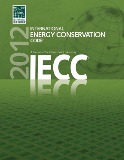 Just like any other scientific field, building science is constantly evolving as new information, testing, and materials are released. Unfortunately in some cases the amount &/or type of information provided is not only hard to understand, but can also be meaningless based on your house or area you live in. With that, welcome to our newest series where we plan on taking common terms & practices and distilling them down like the popular “for Dummies™” books do so well.
Just like any other scientific field, building science is constantly evolving as new information, testing, and materials are released. Unfortunately in some cases the amount &/or type of information provided is not only hard to understand, but can also be meaningless based on your house or area you live in. With that, welcome to our newest series where we plan on taking common terms & practices and distilling them down like the popular “for Dummies™” books do so well.
Energy Codes are very similar to building codes with some subtle but very notable changes:
|
IRC – Building Code |
IECC – Energy Code |
| Preface: This comprehensive, stand-alone residential code establishes minimum regulations for one- and two-family dwellings and townhouses using prescriptive provisions. | Preface: Same wording but added in words “and performance based” provisions |
| Intent: The purpose of this code is to establish minimum requirements to safeguard the public safety, health and general welfare… | Intent: This code shall regulate the design and construction of buildings for the effective use of energy… |
| Existing: Additions, alterations or repairs to any structure shall conform to the requirements for a new structure without requiring the existing structure to comply with all of the requirements of this code, unless otherwise stated. (e.g. fire detectors, fuse boxes, & similar items have to be brought up to code) | Existing: Additions, alterations, renovations or repairs to an existing building, building system or portion thereof shall conform to the provisions of this code as they relate to new construction without requiring the unaltered portion(s) of the existing building or building system to comply with this code. |
Most of the country either uses or will soon be using the IECC which address both Residential & Commercial Buildings. One major exception is California which has its own version commonly referred to as Title 24.
Unlike the Building codes where the AHJ is responsible for setting the minimum code or standard to be enforced, this has been “voluntarily” ceded over to the Department of Energy, the IECC committee, ASHRAE, ANSI, and IESNA. While each local AHJ can amend the codes, they can only modify them so that they meet or exceed the current standard.
The Confusion:
 Unfortunately there has been a ton of confusion on the subject as most people have yet to read the acts that pertain to this or simply rely on what others have stated. One “white paper” in particular (especially seeing it was put out by the USGBC & many other preeminent organizations) has also added to this confusion. While the paper was technically correct when it was written & they did include the proper language, they simply listed that it was 2009 IECC that had to be met but forgot to emphasize the “most recently published” language. In short, by February 17th, 2017 all states must have adopted & have a 90% compliance rate based on the 2012 IECC. UPDATE: All states must adopt the 2015 IECC no later than June 12th, 2017.
Unfortunately there has been a ton of confusion on the subject as most people have yet to read the acts that pertain to this or simply rely on what others have stated. One “white paper” in particular (especially seeing it was put out by the USGBC & many other preeminent organizations) has also added to this confusion. While the paper was technically correct when it was written & they did include the proper language, they simply listed that it was 2009 IECC that had to be met but forgot to emphasize the “most recently published” language. In short, by February 17th, 2017 all states must have adopted & have a 90% compliance rate based on the 2012 IECC. UPDATE: All states must adopt the 2015 IECC no later than June 12th, 2017.
 Levels of enforcement vary based on locations. To see where your state stands in this Energy Code Adoption: Energy Codes .govIn order for your home to be as “efficient” as it is supposed to be, at minimum make sure you specify that you will want copies of the Blower Door Test, Duct Leakage Results & the Manual J. Levels of enforcement vary based on locations. To see where your state stands in this Energy Code Adoption: Energy Codes .govIn order for your home to be as “efficient” as it is supposed to be, at minimum make sure you specify that you will want copies of the Blower Door Test, Duct Leakage Results & the Manual J. |
How the “most recent” becomes the standard:
Under Title III of the Energy Conservation and Production Act (ECPA), DOE has one year to review each new energy code or revision that comes out to see if it does improve the energy efficiency & see if it should be adopted. At this time a final determination is made it has to be posted on the Federal Registrar (2012’s final determination). Based on the date that the final determination is posted, each state has two years to certify that it has compared its code to the newer one for revisions. While the language allows for an out (e.g. not appropriate finding) the ARRA act has basically stripped that away for this round.
UPDATE: As for the 2015 code DOE made their final determination on June 11th of 2015 meaning that by June 12th of 2017 that all states must be at that level.
 The American Recovery and Reinvestment Act of 2009SEC. 410. ADDITIONAL STATE ENERGY GRANTS The American Recovery and Reinvestment Act of 2009SEC. 410. ADDITIONAL STATE ENERGY GRANTS
(a) IN GENERAL.— Amounts appropriated under the heading ‘‘Department of Energy—Energy Programs—Energy Efficiency and Renewable Energy’’ in this title shall be available to the Secretary of Energy for making additional grants under part D of title III of the Energy Policy and Conservation Act (42 U.S.C. 6321 et seq.). The Secretary shall make grants under this section in excess of the base allocation established for a State under regulations issued pursuant to the authorization provided in section 365(f) of such Act only if the governor of the recipient State notifies the Secretary of Energy in writing that the governor has obtained necessary assurances that each of the following will occur: (1) The applicable State regulatory authority will seek to implement, in appropriate proceedings for each electric and gas utility, with respect to which the State regulatory authority has ratemaking authority, a general policy that ensures that utility financial incentives are aligned with helping their customers use energy more efficiently and that provide timely cost recovery and a timely earnings opportunity for utilities associated with cost-effective measurable and verifiable efficiency savings, in a way that sustains or enhances utility customers’ incentives to use energy more efficiently. (2) The State, or the applicable units of local government that have authority to adopt building codes, will implement the following: (A) A building energy code (or codes) for residential buildings that meets or exceeds the most recently published International Energy Conservation Code, or achieves equivalent or greater energy savings. (B) A building energy code (or codes) for commercial buildings throughout the State that meets or exceeds the ANSI/ASHRAE/IESNA Standard 90.1–2007, or achieves equivalent or greater energy savings. (C) A plan for the jurisdiction achieving compliance with the building energy code or codes described in subparagraphs (A) and (B) within 8 years of the date of enactment of this Act in at least 90 percent of new and renovated residential and commercial building space. Such plan shall include active training and enforcement programs and measurement of the rate of compliance each year |


State and local jurisdictions are amending the 2009 IECC to a lower level of efficiency. The DOE has indicated that it will not pursue legal action against these jurisdictions, and any others that do not adopt and enforce the 2009 IECC, so there is no teeth in the Federal law. The Governor of Wyoming told the DOE that Wyoming as a state will not enforce a state energy code because it is a local issue. He then accepted the ARRA DOE energy funding which was readily provided despite any show of commitment by the Governor.
State and local jurisdictions are amending the 2009 IECC to a lower level of efficiency. The DOE has indicated that it will not pursue legal action against these jurisdictions, and any others that do not adopt and enforce the 2009 IECC, so there is no teeth in the Federal law. The Governor of Wyoming told the DOE that Wyoming as a state will not enforce a state energy code because it is a local issue. He then accepted the ARRA DOE energy funding which was readily provided despite any show of commitment by the Governor.